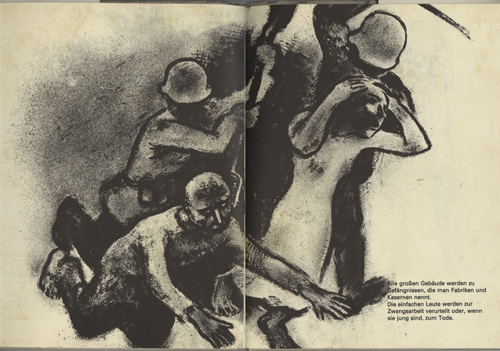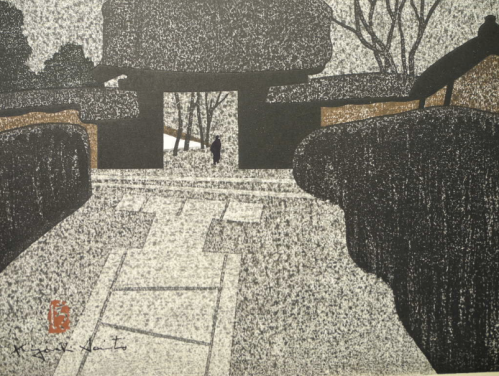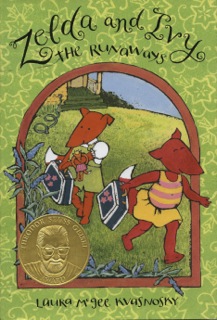Moving to London has brought new challenges, which is in part why the move appealed to me.
But moving someplace new doesn’t mean you don’t seek out the familiar.

Last October I visited the London Print Studio on the recommendation of a friend. Perhaps it was the scent of burnt linseed oil, but I immediately felt at home.
The studio offers classes and studio work sessions for printmakers. It also has a gallery space and small shop.
I signed up for a screenprint workshop. It was good. I asked if they could use any volunteer workers (I figured I might as well make myself useful while I’m here). They said Yes.
I met with the LPS founder and director John Phillips and the operations manager Nadia Yahiaoui. They asked me to put together a print media display for their upcoming 40th anniversary exhibit, “Printopia – How and Why Artists Reproduce.”
In addition to showcasing all of the techniques the studio provides equipment and materials for – letterpress printing, etching, screenprinting (or silkscreen) and stone lithography – John also asked me if I would like to produce a print to demonstrate each technique in the display.
Well sure. I am still fairly new to silkscreen, I haven’t made an etching since the early 80s, and I’ve never done stone litho. But hey, why not?
Fortunately, I had help from many, but especially from the LPS Print Studio Coordinator, Darren van der Merwe, who was kind and patient enough to give me an very quick intro to stone litho.

To start with, I had an excerpt from Victor Hugo’s Notre Dame de Paris that John planned to use for the letterpress demo. The piece is from the chapter, “This will destroy That. The Book will destroy the Edifice.”

I decided to interpret (illustrate) this quote in the three remaining media, adapting the image to suit each technique.
I started with etching.This is the first state (proof stage) of the image done freehand on hard ground.

I then moved on to the stone lithography piece. This involves drawing on a slab of finely grained limestone mined from Jurassic Era deposits. A fresh stone has a surface Darren describes as “like velvet.” It instantly absorbs any grease you apply, including that from your skin. Wherever the grease is absorbed will show up on the final print. If you mess up, the stone has to be ground down. Grinding down a stone takes hours. I didn’t want to mess up. It was a bit intimidating.
After drawing on my stone for a while it occurred to me that I am not really a line-work person. I am much more comfortable working with form, which is probably why I mostly work in relief printing where I can cut out shapes and leave the line-work to my preliminary drawings. My litho image was looking very timid.
I went looking for Darren, who suggested I could move some of the line around with tusche and even remove some of what I had done with mineral spirits.
That’s when things got really messy but much more productive. I began rubbing out lines, cutting out stencils (shapes) and splattering tusche. I got so carried away I dissolved some of the gum arabic that Darren had laid down to mask out the border areas. It doesn’t resemble what I started out with, but I am relieved and pleased with the end result. It looks like I meant to do whatever it was I did.

I then proceeded to add aquatint to my etching plate. However, I misread the handy timing guide posted in the acid room. The sign showed progressive darknesses of aquatint with a guideline that read; 5″, 10″, 15″, etc. I thought ” meant minutes, but it wasn’t till I had dunked my plate in the acid four times, for a total of sixteen minutes, did I realize that ” meant seconds. #@$%&
So I ended up with a very dark plate, but at least the print doesn’t look timid!

That left the silkscreen image, which I had no choice but to create digitally and send to Darren to transfer to the screen and print.


Darren printed everything for me as I had to leave town for two weeks in the middle of the exhibit preparations. I came back with barely enough time to build the displays before the opening.
John had purchased thin metal sheeting imagining it could be sandwiched between the printed images and a blank sheet of paper to create the effect of the prints “magically” lifting off the plates. I was skeptical. I tested it out. It worked beautifully.


I assembled the displays, and now I can add display-building to my list of new skills.
I had fun. I problem-solved. I got to work with a great group of art people. I created my first (and perhaps only) stone litho image. I made something useful. The LPS gained an extra pair of hands for a few weeks and I felt welcomed. I’m looking forward to the next challenge.














 When I wrote
When I wrote 

























































































 “Two Men Discussing Coming Hunt” -Kavagawak
“Two Men Discussing Coming Hunt” -Kavagawak “The Arrival of the Sun” -Kenojuak
“The Arrival of the Sun” -Kenojuak


 Image for Hello, Arctic!, 2002
Image for Hello, Arctic!, 2002












